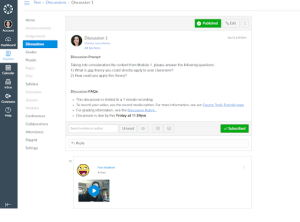
According to Vanderbilt University, “discussion boards are arguably the most important part of the online course.” Over the past 15 years, we have helped a bunch of students with their online classes, and discussions make up a considerable percentage of their final grades. In an online course, discussion boards provide that same visible, interactive space for students to interact academically and socially with their peers. Asynchronous, online discussions where students can process the material, interact with each other, and form a collaborative community are key to successful online teaching. The following are key to providing quality discussions and responses to peers.
1. Learn how to manage your time well
Most students want to wait until the last minute to participate in the discussion board. This is dangerous, particularly when the question is challenging. Do not wait until Wednesday at 9 PM to post a discussion due by midnight. Your adrenaline might not allow you to provide quality posts. I understand that procrastination is a building block of a normal student, but it can waste brilliant students. In most universities, such as Chamberlain University and UMGC, all 8-weeks discussions are visible on week one. It is advisable to copy all discussions on a word document and indicate their due dates. This will help you to stay updated and keep time. Every university has its own due dates for discussions and responses. For instance, UMGC sets Friday Midnight as the last day for making the initial post and Tuesday as the last day for posting responses. Most universities set Wednesday at Midnight as the last day for making the initial post and Sunday for posting responses. Of course, a good student will make the initial post on Tuesday and respond on Friday before breaking for the weekend.
2. Read and understand the discussion question
Under any given circumstance, read and understand the question. You might not want to go to San Diego when everyone else is going to San Bruno. It is important to answer the question correctly so that you do not give your peers a hard time figuring out what you are talking about.
3. Keep your Initial Post Short and Concise
Have you ever wondered why students bypass long posts and rush to respond to short posts? The answer is simple. No one wants to spend several minutes reading a long post. Your peers want you to write a short and concise post to help them respond accordingly. Albeit, I do not intend to discourage students from responding to long posts. It is your choice. If you procrastinate until Sunday and find your peers have responded to all short posts, you do not have any choice but to respond to long posts. Students are encouraged to respond to posts without responses.
4. Support your Posts with Sources
Like research papers, discussion posts MUST be supported with evidence, outside sources, or course materials. All weekly discussions are designed from weekly readings. Cite your sources perfectly and indicate all sources on the reference page. If not indicated, use APA Citation.
How to Provide Quality Responses to Peers’ Posts
Normally, students are required to respond/reply to at least two peers. To provide a quality reply, you need to read your peer’s post carefully. Responding to peers’ posts allows you to think more deeply about concepts and view them from other perspectives. You may either agree or disagree with your peer’s perspectives. If you disagree with someone’s post, you should aim to acknowledge your disagreement maturely and respectfully. Ask questions for clarification because your disagreement may result from a misunderstanding. Do not use derogatory or disrespectful terms because the main aim of the discussion board is to learn (help others gain knowledge) and not to demean them. If you agree with the peer’s perspective, acknowledge why you agree. Add more information to expand your peer’s point of view. Cite your reply where necessary.
